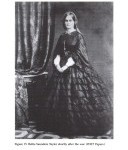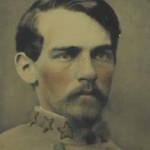A Most Unusual Wartime Wedding
Four Saunders siblings from Norfolk, Virginia served the Confederacy: three brothers enlisted in the military, and their oldest sister worked for the government in Richmond.
Elizabeth Selden Saunders was among hundreds of young women who moved into the South’s capital city during the war. In a wartime memoir, Richmond During the War, Sallie B. Putnam writes that “hundreds of intelligent and deserving women of the South. . . by the existence of the war, had been so reduced in the means of living as to be compelled to earn a support” and sought government jobs. Elizabeth– nicknamed Bettie– worked first for the Treasury Department and later for the Surgeon General’s Office.
Her suitor was Walter Herron Taylor. Also from Norfolk, Taylor spent the war as a staff officer for Robert E. Lee. The general considered Stonewall Jackson his “right hand” in the field, but Taylor was his right hand at headquarters, the man he trusted to draft and deliver important documents, to conduct reliable reconnaissance, and to communicate verbally with generals in the field.
Taylor was at Lee’s side as the Army of Northern Virginia moved across its home state and into the North for battles at Antietam and Gettysburg, forcing him to court Bettie mostly through letters, over 100 of which have survived.
Beginning in June 1864, the seige of Petersburg brought the young couple within a few miles of one another. From then until the spring of 1865, the Army of the Potomac and the Army of Northern Virginia faced each other from trenches around the strategic railroad hub twenty-five miles south of Richmond. Grant’s army was large and well-fed. Lee’s was smaller, malnourished, and dispirited; desertions became epidemic.
*****
The situation permitted Taylor to visit Bettie in Richmond occasionally, but he knew the Confederates could not wrest Petersburg from the grip of the Union army that steadily extended its lines south and west to cut the railroads supplying Petersburg and Richmond.
In April 1865: The Month That Saved America, author Jay Winik reveals that by January Lee had decided removing the Confederate government and military forces from Richmond would strengthen his chances of continuing the war. He would have to wait for better weather and dryer roads to move wagons and artillery.
Lee used the time to devise a plan to withdraw most of his forces from Petersburg at an opportune time and move them west and south ahead of their Yankee pursuers. His goal was joining General Joe Johnston’s Army of Tennessee in North Carolina. Once there, Winik says, Lee hoped to “dictate the time and pace of warfare” against Grant.
For the Confederate government to remain operational, officials would have to leave Richmond before Union troops entered once its defenders joined Lee’s retreating forces. Taylor, now a Lieutenant Colonel and Lee’s Assistant Adjutant General, was instrumental in the development of Lee’s evacuation plans.
*****
Taylor sent Bettie yet another letter in mid-March 1865. She described its contents and her reaction to them in “My Wedding,” a pamphet she wrote in 1912 to benefit a Norfolk hospital:
Two weeks before General Lee’s determination to leave Richmond . . . , I received a letter from Col. Taylor asking if in such an event I would consent to marry him at once. He had secured my mother’s permission and thought that as his wife I could pass more safely through Union lines. My heart was with the South and I wrote my glad assent.
The couple planned to be married by Dr. Charles R. Minnegerode, the Rector of St. Paul’s Episcopal Church, which counted many Richmond notables, including President Jefferson Davis, among its congregation. Minnegerode had previously served a church in Norfolk and knew the young couple. Bettie was to make arrangements with him.
*****
Winik writes that as late as March 28, Lee thought he had 10-12 days to prepare for an orderly removal of his army from Petersburg and Richmond, a time frame that would permit Taylor and Bettie to have a traditional, albeit simple, wedding. Three days later, however, Lee must have felt the gods of war had played a cruel April Fool’s Day joke on the Army of Northern Virginia.
Late in the afternoon of Saturday, April 1, Union cavalry and infantry broke through the thin Confederate lines at Five Forks, a critical spot in Lee’s outer defensive line southwest of Petersburg. The next morning, Union troops reached Lee’s headquarters northeast of Five Forks.
*****
Sunday was no day of rest for Lee and his staff as they rushed to revise retreat plans, but Taylor managed to send a personal telegram to Richmond. The recipient was not Bettie, but his younger brother, Major Robertson Taylor.
The wire read, “I will be over some time today. See Bettie and have her explain. Make all needed preparations.” The message baffled the major, but he immediately went to the home of Lewis D. Crenshaw where Bettie was staying. Crenshaw was a wealthy Richmond businessman whose woolen and flour mills provided food and clothing for both soldiers and civilians.
Bettie explained to Major Taylor that Walter’s message meant “Richmond was to be evacuated” and that she and Walter would be married whenever he arrived. She left it to the major to inform his mother and siblings now living in the capital city of the impending wedding.
Bettie recalls in “My Wedding,” that once she convinced an incredulous Crenshaw of Lee’s imment withdrawal, “he then went at once to see about his papers, etc.” Bettie went to services at St. Paul’s Church, “leaving directions for Walter to join” her there.
At the church, Bettie witnessed the oft-described scene of Jefferson Davis’s walking out mid-service after being handed a note from Secretary of War John C. Breckinridge.
Bettie may have been the only member of the congregation who knew the gist of that communication with certainty, but her exclusivity was short-lived. Soon alarm bells– the nineteenth-century equivalent of warning sirens– began ringing. Dr. Minnegerode announced from the pulpit that all women should go home, but Bettie worked her way through exiting congregants to the front of the church.
After alerting Minnegerode that he was on call to perform a wedding at a moment’s notice, Bettie returned to the Crenshaw house to find “everyone feeding our poor, ragged hungry soldiers as they passed.” She later wrote that she could not remember “how many barrels of flour had been made into biscuits and hoe-cakes,” but Crenshaw had been generous with his mill’s output.
Bettie helped serve the soldiers, expecting Taylor to appear at any time. The flow of hungry men slowed as darkness fell, and Bettie’s friends helped the bride prepare for her wedding. For her gown, they found “a new black mouselaine lined with grey linen.” The ailing and bedridden Mrs. Crenshaw contributed a pair of white kid gloves. All that was needed was the groom. Finally, a telegram came saying that Taylor was on his way.
*****
Colonel Taylor spent Sunday issuing orders for the evacuation. At the end of the day, he asked Lee for permission to go to Richmond to say good-bye to his relatives and to marry Bettie. The surprised Lee gave his assent, and Taylor spurred his horse to the Dunlop station of the Richmond & Petersburg railroad, arriving as the last train to Richmond vanished in the distance.
In a scene one would expect only from Hollywood, Taylor ordered the station agent to detach his only remaining engine from an ambulance train waiting to evacuate Petersburg’s last wounded soldiers to hospitals in Richmond. (Being Lee’s top aide had its perks.) Instructing a courier to take his horse to Richmond, Taylor lept onto the locomotive and ordered the engineer to overtake the northbound train. Finally catching the train at a station three-quarters of the way to Richmond, Taylor boarded it and sent his chase engine back to Petersburg.
*****
Taylor finally arrived at the Crenshaw home at 12:30 a.m. on April 3, having taken time to pick up his family and Dr. Minnegerode. He and Bettie were married in an upstairs sitting room so that Mrs. Crenshaw could attend.
Crenshaw provided what Bettie later called “a delicious repast” for the small wedding party, after which the newlyweds went to the home of Taylor’s mother to visit with his brothers Richard and John, recently released prisoners of war. Around 4:00 a.m. Taylor escorted Bettie back to the Crenshaw home. The courier had delivered Taylor’s horse, and Taylor, accompanied by Bettie’s borther Colonel John S. Saunders, rode through Richmond’s chaotic streets, crossed the Mayo Bridge, and rode into the final days of the Confederacy. Taylor described the scene as follows in his book General Lee: His Campaigns in Virginia 1861-1864:
[We] proceeded toward the south side of the James in the lurid glare of the fire and within the sounds of several large explosions that we took to be the final scene in the career of the Confederate navy, then disappearing in smoke on the James River. . . .
Accoding to Bettie, they “were about the last persons to pass over the bridge . . . before it was set on fire.”
*****
One week later the war was over for the Army of Northern Virginia. Two weeks later Robert E. Lee returned to his family in Richmond, Walter Taylor still at his side. After two more weeks, Taylor borrowed an ambulance and a team of mules from Lee, and he and Bettie began their honeymoon, a month-long drive back to Norfolk.
Taylor embarked upon a successful career including banking, law, and politics. He also authored two books about Robert E. Lee, Four Years with General Lee (1877) and Robert E. Lee: His Campaign in Virginia, 1861-1865, with Personal Remembrances (1906). He and Bettie became the parents of eight children, four boys and four girls.
The Taylors’ most unusual wartime wedding began a marriage that lasted fifty-one years. Walter died of cancer on March 1, 1916. Bettie’s death came a mere four months later.

